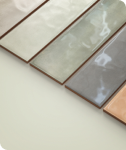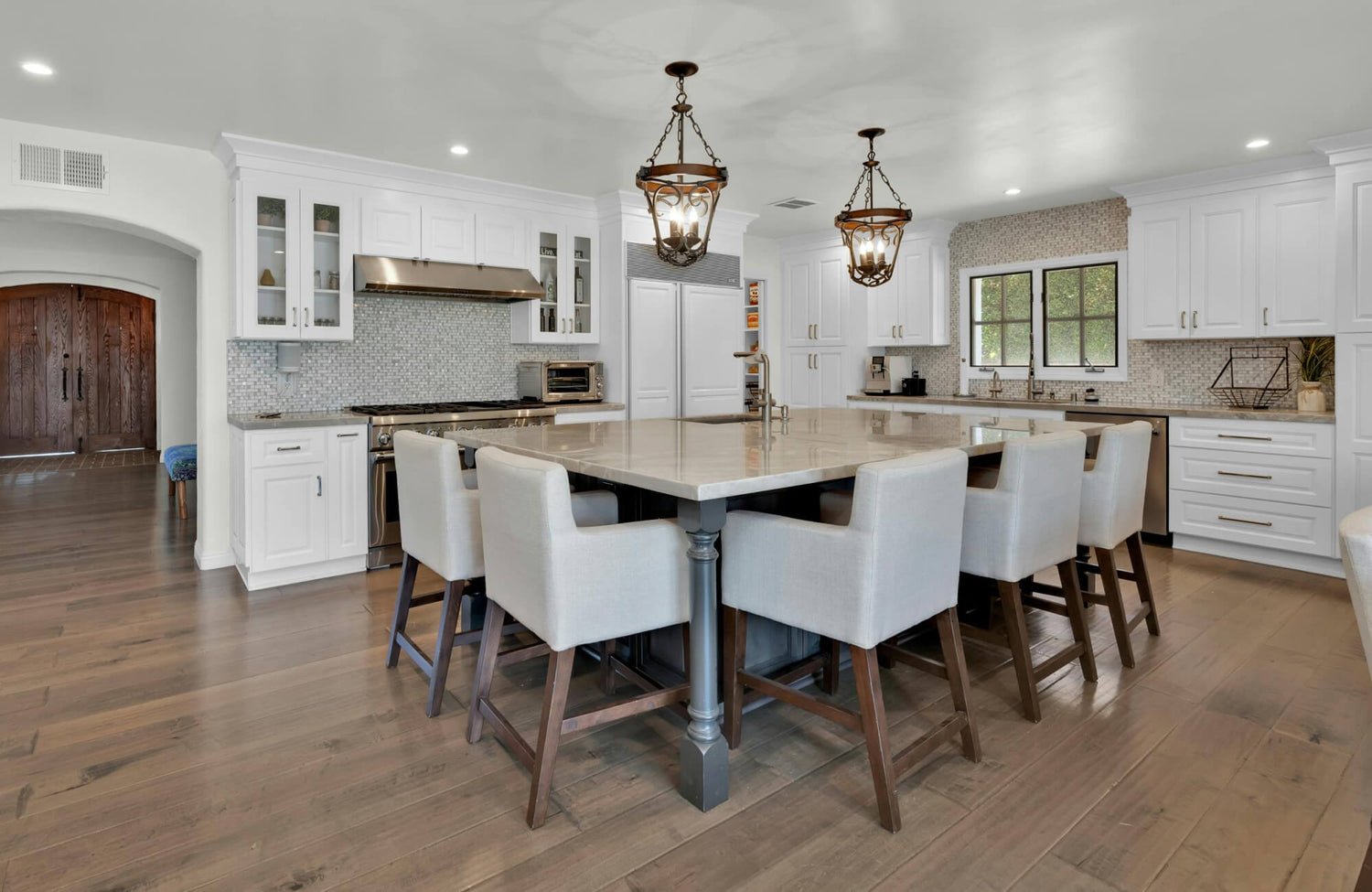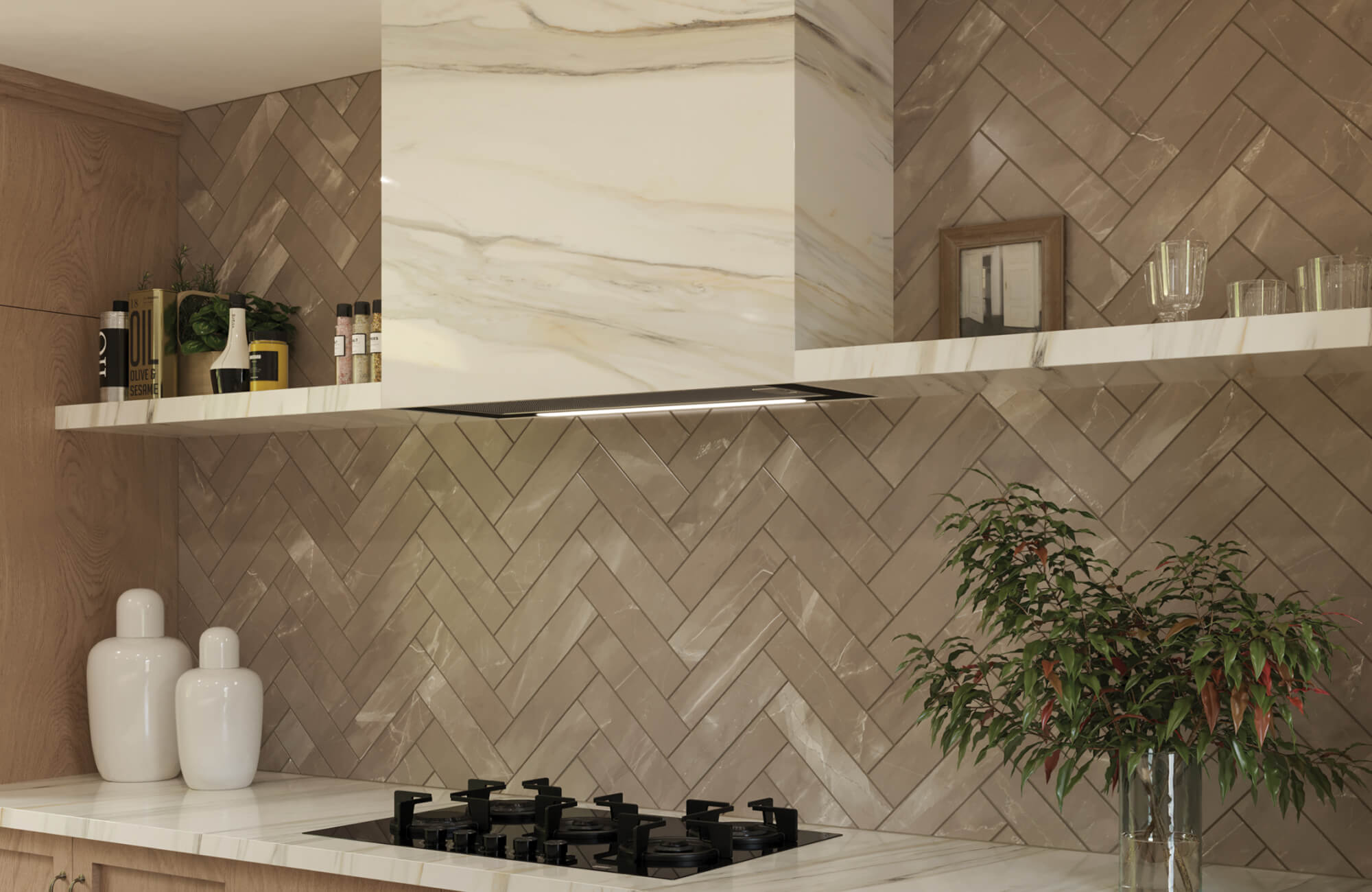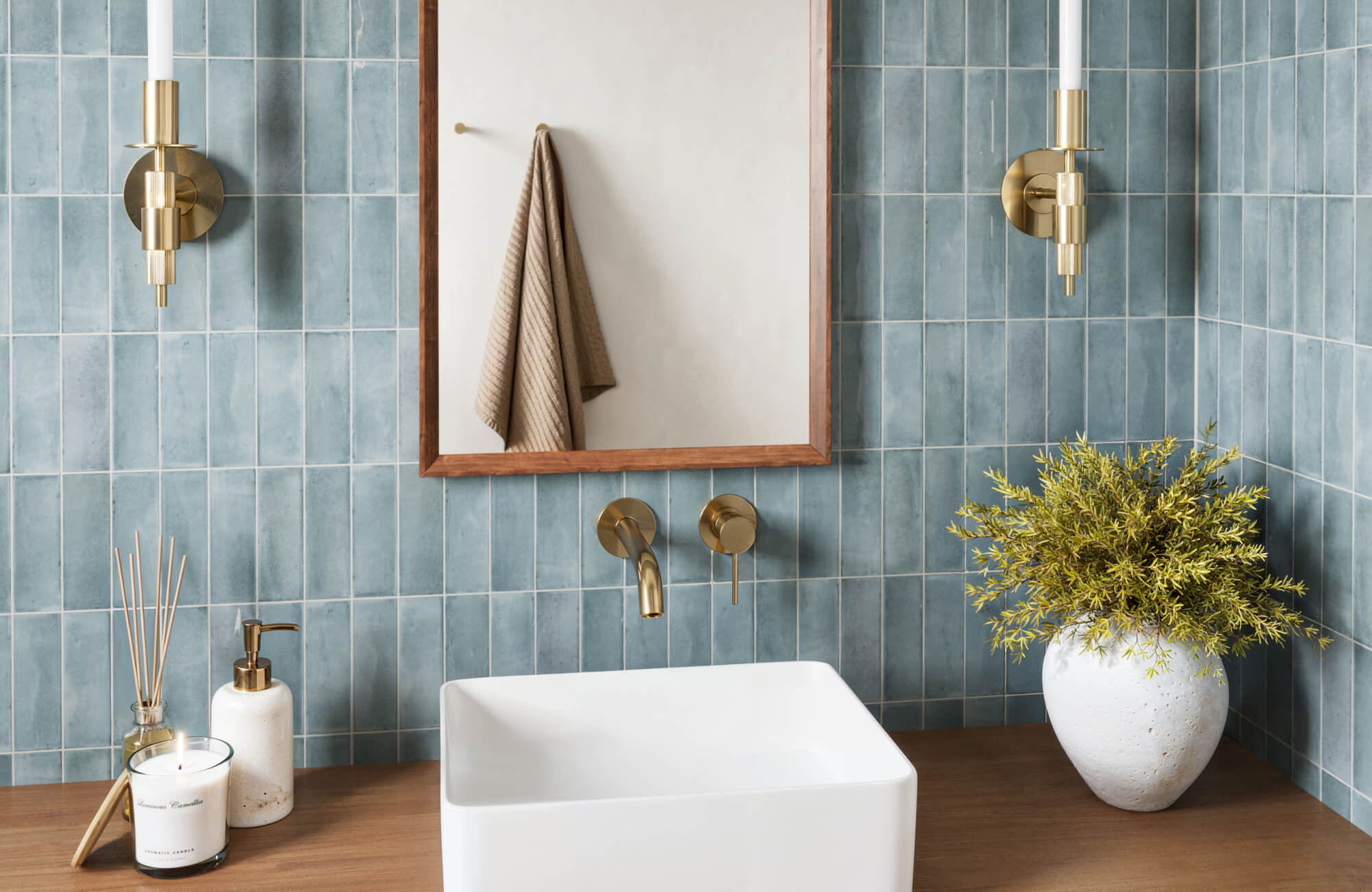Wood flooring, with its timeless elegance and natural warmth, can elevate the aesthetic appeal of any kitchen. However, the kitchen's unique challenges, including spills, grease, and constant use, can pose significant risks to the longevity and beauty of wood floors. To ensure that your kitchen's wood flooring remains stunning for years to come, it's essential to implement effective protection strategies. In this article, we will explore various tips and techniques to safeguard your wood floors and keep them looking their best.

Understanding the Risks
Before we dive into the protective measures, it's crucial to understand the specific threats that wood floors face in a kitchen environment.
Water Damage
Water, though essential in any kitchen, poses a significant threat to wood floors. Even minor spills can penetrate the wood’s surface, leading to swelling, warping, or, in severe cases, rotting. Prolonged exposure to moisture creates an ideal environment for mold and mildew, further compromising the structural integrity and appearance of the floor. Water damage can often be irreversible, underscoring the importance of proactive prevention and immediate cleanup to safeguard your wood flooring.
Grease and Oil Spills
Grease and oil spills are frequent in kitchens and can significantly harm wood floors. These substances can penetrate the wood's surface, resulting in discoloration, warping, and sticky residues that attract dirt and grime. Over time, this buildup can erode the finish, leaving the wood exposed to further damage. Proper cleaning and protective measures are essential to mitigate the impact of grease and oil spills.
Foot Activity and Scratches
The constant movement in a kitchen places considerable strain on wood floors, leading to scratches, dents, and diminished shine. High-heeled shoes, pet claws, dropped objects, and abrasive debris tracked in from outside are common culprits. Implementing preventive steps and maintaining a regular cleaning routine can help minimize the effects of everyday wear and tear, preserving the floor’s beauty and durability.

Protective Measures
To safeguard your kitchen's wood floors from the daily wear and tear of kitchen life, implementing a few protective measures is essential. These steps can help preserve the beauty and longevity of your flooring, ensuring it remains a stunning centerpiece in your home.
High-Quality Finishes
The finish on your kitchen wood floors serves as a critical protective barrier, safeguarding them from the wear and tear of daily activities, including spills, scratches, and stains. Polyurethane is a widely popular choice due to its durability and water resistance, forming a hard, protective layer that can withstand heavy use. Oil-based polyurethane offers a glossy, long-lasting finish resistant to wear, while water-based polyurethane provides a more natural appearance, quick drying times, and low VOC emissions, making it an eco-friendly option. Both types ensure robust protection, but water-based finishes are less prone to yellowing over time.
Alternatively, wax finishes offer a softer, more natural aesthetic. While they require more frequent reapplication, they are easy to repair and can beautifully enhance the wood’s natural grain, making them suitable for less busy areas or homeowners seeking a low-sheen look. Regardless of the finish you choose, regular maintenance is essential to preserve its effectiveness. Clean your floors with a mild cleaner and a soft cloth, avoiding harsh chemicals that could damage the finish. Periodically inspect your floors for signs of wear, such as scratches or fading, and reapply a fresh coat of finish as needed to maintain their beauty and protection. With the right finish and proper care, your wood floors can remain resilient and visually stunning for years to come.
Reapplying Protective Coatings
To ensure optimal protection, it's essential to reapply protective coatings periodically. The frequency of reapplication depends on various factors, including the type of finish, the level of foot usage, and the severity of wear and tear.
For polyurethane finishes, a light sanding followed by a fresh coat of finish every 2-3 years is typically recommended. This helps to maintain the protective layer and restore the original shine. Wax finishes, being less durable, may require more frequent reapplication, possibly every 6-12 months.
Area Rugs and Mats
Area rugs and mats can help protect your kitchen floor from damage, especially in busy areas. They can absorb spills, reduce the impact of frequent use, and add a touch of style to your kitchen. When choosing rugs and mats, consider factors such as size, material, and color.
Opt for rugs and mats made from durable materials that can withstand spills and stains. Rubber-backed mats are a good choice for busy areas, as they can help prevent slipping and sliding. Additionally, choose rugs and mats that are easy to clean and maintain. Regular vacuuming and spot cleaning can help keep your rugs and mats looking their best.
Regular Cleaning and Maintenance
Regular cleaning, maintenance, and seasonal humidity management are essential for preserving the beauty and longevity of your wood floors. Start with consistent sweeping or vacuuming to remove dirt and debris. For deeper cleaning, use a damp mop with a mild, pH-neutral cleaner, ensuring you avoid excessive water to prevent warping or damage. Promptly clean up spills by blotting them with a clean cloth and drying the area thoroughly to avoid staining or water damage. For stubborn stains, consider consulting a professional cleaner.
Periodically, refinishing your wood floors can restore their appearance and extend their lifespan. This process involves sanding down the old finish and applying a new protective layer, revitalizing the wood's surface. Additionally, managing seasonal humidity levels is critical. Use a dehumidifier during summer to reduce excess moisture and prevent expansion or warping. In winter, a humidifier helps maintain optimal humidity, protecting the wood from cracking. Together, these practices ensure your wood floors remain beautiful and durable for years to come.

Additional Tips for Kitchen Wood Floors
In addition to the fundamental protective measures, there are a few extra tips you can implement to further safeguard your kitchen's wood floors. These small details can make a significant difference in the long-term health and appearance of your flooring.
Appliance Mats
Heavy kitchen appliances, such as refrigerators, stoves, and dishwashers, can put significant pressure on your wood floors, leading to dents and scratches. To mitigate this risk, consider using appliance mats. These mats are designed to distribute the weight of appliances evenly, reducing the pressure on the floor.
When choosing appliance mats, opt for durable materials like rubber or felt. Ensure that the mats are large enough to cover the entire footprint of the appliance. Additionally, regularly inspect the mats for signs of wear and tear, and replace them as needed.
Furniture Pads
Furniture pads are another essential tool for protecting your wood floors. Chairs, tables, and other furniture items can cause scratches and dents, especially if they are frequently moved. By placing furniture pads on the legs of your furniture, you can create a barrier between the wood and the floor.
When selecting furniture pads, consider the weight of your furniture and the type of flooring. Felt pads are a good option for lighter furniture, while rubber or silicone pads are better suited for heavier items. Regularly inspect the furniture pads and replace them if they become worn or damaged.

Monitoring and Repairing Damage
While preventative measures are crucial, it's important to be vigilant and address any damage to your wood floors promptly. By monitoring your floors regularly and taking timely action, you can preserve their beauty and longevity.
Spotting Early Signs of Damage
Regularly inspecting your wood floors is crucial for identifying and addressing potential issues early on. Keep an eye out for signs of water damage, such as discoloration, warping, or mold growth. Scratches and dents are also common, especially in busy areas. Promptly addressing these issues can prevent further damage and costly repairs.
DIY Fixes for Minor Issues
For minor scratches and dents, you can often make repairs yourself. Wood repair markers are a convenient solution for concealing superficial scratches. Simply apply the marker to the damaged area, following the wood's grain. For deeper scratches or dents, you may need to sand the affected area and apply a wood filler. Once the filler has dried, sand the area smooth and reapply the finish.
Professional Restoration for Severe Damage
If your wood floors have sustained significant damage, such as deep scratches, water damage, or extensive wear and tear, it's best to consult a professional wood floor restoration specialist. These experts have the knowledge and tools to assess the damage and recommend the appropriate course of action.
Professional restoration services may include sanding, refinishing, and staining. Sanding removes the top layer of damaged wood, revealing the fresh wood beneath. Refinishing involves applying multiple coats of finish to protect the wood and restore its shine. Staining can be used to enhance the wood's natural color or to create a completely new look.
Alternative to Wood Floors
While wood flooring offers undeniable beauty and warmth, it's not the only option for your kitchen. If you're looking for a more durable and low-maintenance alternative, consider these options:
Considering Engineered Wood Alternatives
If you're concerned about the potential drawbacks of solid wood flooring in a kitchen environment, consider engineered wood. Engineered wood flooring comprises multiple layers of wood, offering enhanced stability and resistance to moisture, temperature fluctuations, and warping. It's a popular choice for kitchens due to its durability and ease of maintenance.
Engineered wood flooring is available in a wide range of styles, colors, and finishes, allowing you to achieve the desired aesthetic. It's important to choose a high-quality engineered wood product, specifically designed for kitchen use.
Wood-Look Porcelain Tiles for Practical and Stylish Spaces
For those seeking the beauty of wood flooring without the maintenance concerns, wood look porcelain tiles offer an excellent solution. These tiles are designed to mimic the appearance of real wood, often indistinguishable from the genuine material. This makes them a popular choice for kitchens and other busy areas.
Exceptionally durable, porcelain tiles are resistant to scratches, stains, and water damage, making them ideal for spaces prone to spills and heavy use. Unlike natural wood, they require minimal upkeep, with regular sweeping and mopping sufficient to maintain their pristine condition. Their water resistance ensures they perform well in moisture-prone environments, eliminating worries about warping, cracking, or fading—additionally, their inherent stability guarantees long-lasting beauty and functionality. With a broad array of styles, colors, and textures available, wood look porcelain tiles seamlessly combine the aesthetic warmth of wood with the durability and low maintenance of porcelain, offering a practical and elegant flooring option for any home.
Key Takeaway
Protecting wood floors in the kitchen requires a thoughtful combination of preventive measures, regular maintenance, and smart design choices. Start by understanding common risks like water damage, grease spills, and frequent use, which can compromise the longevity of your flooring. Implement effective strategies such as applying high-quality finishes, reapplying protective coatings, and incorporating area rugs or furniture pads to protect against wear and tear while preserving the timeless charm of wood flooring.
Enhance your floors’ resilience and beauty with regular cleaning routines, the use of appliance mats, and professional restoration when needed. For homeowners seeking alternatives, engineered wood or wood look porcelain tiles provide a durable, low-maintenance option without sacrificing style. By assessing your kitchen’s unique challenges, applying these strategies, and consulting professional advice for more complex situations, you can ensure your wood floors remain a stunning and enduring feature of your home.








